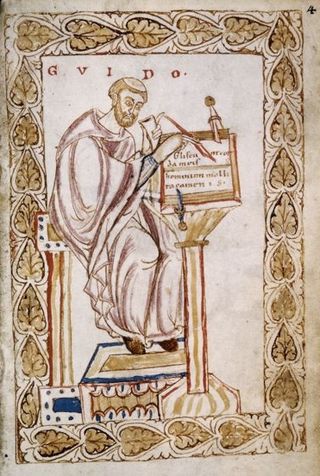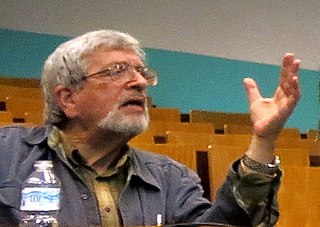
The Renaissance is a period in history and a cultural movement marking the transition from the Middle Ages to modernity,covering the 15th and 16th centuries and characterized by an effort to revive and surpass the ideas and achievements of classical antiquity;it was associated with great social change in most fields and disciplines,including art,architecture,politics,literature,exploration and science. It began in the Republic of Florence,then spread to the rest of Italy and later throughout Europe. The term rinascita ("rebirth") first appeared in Lives of the Artists by Giorgio Vasari,while the corresponding French word renaissance was adopted into English as the term for this period during the 1830s.

Guido of Arezzo was an Italian music theorist and pedagogue of High medieval music. A Benedictine monk,he is regarded as the inventor—or by some,developer—of the modern staff notation that had a massive influence on the development of Western musical notation and practice. Perhaps the most significant European writer on music between Boethius and Johannes Tinctoris,after the former's De institutione musica,Guido's Micrologus was the most widely distributed medieval treatise on music.

The Last Supper is a mural painting by the Italian High Renaissance artist Leonardo da Vinci,dated to c. 1495–1498,housed in the refectory of the Convent of Santa Maria delle Grazie in Milan,Italy. The painting represents the scene of the Last Supper of Jesus with the Twelve Apostles,as it is told in the Gospel of John –specifically the moment after Jesus announces that one of his apostles will betray him. Its handling of space,mastery of perspective,treatment of motion and complex display of human emotion has made it one of the Western world's most recognizable paintings and among Leonardo's most celebrated works. Some commentators consider it pivotal in inaugurating the transition into what is now termed the High Renaissance.
Well temperament is a type of tempered tuning described in 20th-century music theory. The term is modeled on the German word wohltemperiert. This word also appears in the title of J. S. Bach's famous composition "Das wohltemperierte Klavier",The Well-Tempered Clavier.

Case Western Reserve University (CWRU) is a private research university in Cleveland,Ohio. Case Western Reserve was established after Western Reserve University—which was founded in 1826 and named for its location in the Connecticut Western Reserve—and Case Institute of Technology—which was founded in 1880 through the endowment of Leonard Case Jr.—formally federated in 1967.
Musica ficta was a term used in European music theory from the late 12th century to about 1600 to describe pitches,whether notated or added at the time of performance,that lie outside the system of musica recta or musica vera as defined by the hexachord system of Guido of Arezzo.

The American Musicological Society (AMS) is a musicological organization which researches,promotes and produces publications on music. Founded in 1934,the AMS was begun by leading American musicologists of the time,and was crucial in legitimizing musicology as a scholarly discipline.
Andreas Werckmeister was a German organist,music theorist,and composer of the Baroque era. He was amongst the earliest advocates of equal temperament,and through this advocacy was highly influential to the harmonic basis underlying almost all of subsequent Western music.

Richard Filler Taruskin was an American musicologist and music critic who was among the leading and most prominent music historians of his generation. The breadth of his scrutiny into source material as well as musical analysis that combines sociological,cultural,and political perspectives has incited much discussion,debate and controversy. He regularly wrote music criticism for newspapers including The New York Times. He researched a wide variety of areas,but a central topic was Russian music from the 18th century to the present day. Other subjects he engaged with include the theory of performance,15th-century music,20th-century classical music,nationalism in music,the theory of modernism,and analysis. He is best known for his monumental survey of Western classical music,the six-volume Oxford History of Western Music. His awards include the first Noah Greenberg Award from the American Musicological Society in 1978 and the Kyoto Prize in Arts and Philosophy in 2017.

The archicembalo was a musical instrument described by Nicola Vicentino in 1555. This was a harpsichord built with many extra keys and strings,enabling experimentation in microtonality and just intonation.

Claude Victor Palisca was an American musicologist. An internationally recognized authority on early music,especially opera of the Renaissance and Baroque periods,he was the Henry L. and Lucy G. Moses Professor Emeritus of Music at Yale University. Palisca is best known for co-writing the standard textbook A History of Western Music,as well as for his substantial body of work on the history of music theory in the Renaissance,reflected in his editorship of the Yale Music Theory in Translation series and in the book Humanism in Italian Renaissance Musical Thought (1985). In particular,he was the leading expert on the Florentine Camerata. His 1968 book Baroque Music in the Prentice-Hall history of music series ran to three editions.
Donald Jay Grout was an American musicologist. He is best known as the author of A Short History of Opera, first published in 1947. The fourth edition was published by Columbia University Press in 2003.
Margaret Bent CBE,is an English musicologist who specializes in music of the late medieval and Renaissance eras. In particular,she has written extensively on the Old Hall Manuscript,English masses as well as the works of Johannes Ciconia and John Dunstaple.
Gary Alfred Tomlinson is an American musicologist and the John Hay Whitney Professor of Music and Humanities at Yale University. He was formerly the Annenberg Professor in the Humanities at the University of Pennsylvania. He graduated from the University of California,Berkeley,with a Ph.D.,in 1979 with thesis titled Rinuccini,Peri,Monteverdi,and the humanist heritage of opera.
Lewis H. Lockwood is an American musicologist whose main fields are the music of the Italian Renaissance and the life and work of Ludwig van Beethoven. Joseph Kerman described him as "a leading musical scholar of the postwar generation,and the leading American authority on Beethoven".
Barbara Russano Hanning is an American musicologist who specializes in 16th- and 17th-century Italian music. She has also written works on the music of 18th-century France and on musical iconography.
J. Peter Burkholder is an American musicologist and author. He is Distinguished Professor Emeritus of Musicology at the Indiana University Jacobs School of Music. He has written numerous monographs,essays,and journal articles on twentieth-century music,Charles Ives,musical borrowing,American music,musical meaning,analysis,and music history pedagogy. He is the principal author of A History of Western Music,10th Edition,published by W. W. Norton &Company.
Adel Verna Heinrich was an American composer,organist,and university teacher. She taught music at Colby College until her retirement in 1988.

David Fenwick Wilson is an American-born Canadian music scholar,educator,and organist whose academic contributions include a treatise on music of the Middle Ages.

Jeffery T. Kite-Powell is an American musicologist and Professor Emeritus at the Florida State University College of Music where he was active from 1984 to 2013. During his tenure at FSU,he was Coordinator of the Music History and Musicology Division from 1996 to 2008. He also directed The Florida State University Early Music Ensembles and in 1989 he founded the vocal group Cantores MusicæAntiquæ. Kite-Powell's primary focuses are the music of the Renaissance and early Baroque periods,organ tablature,historical performance practice,and Michael Praetorius.










